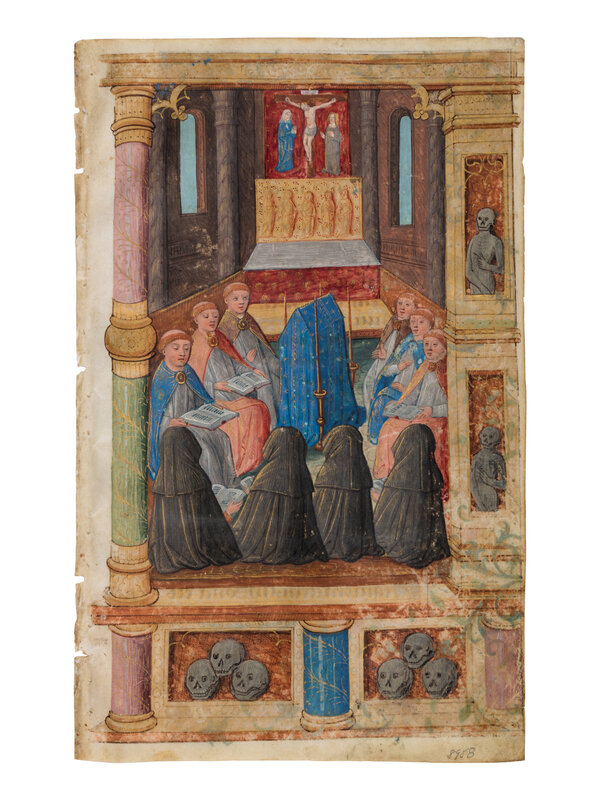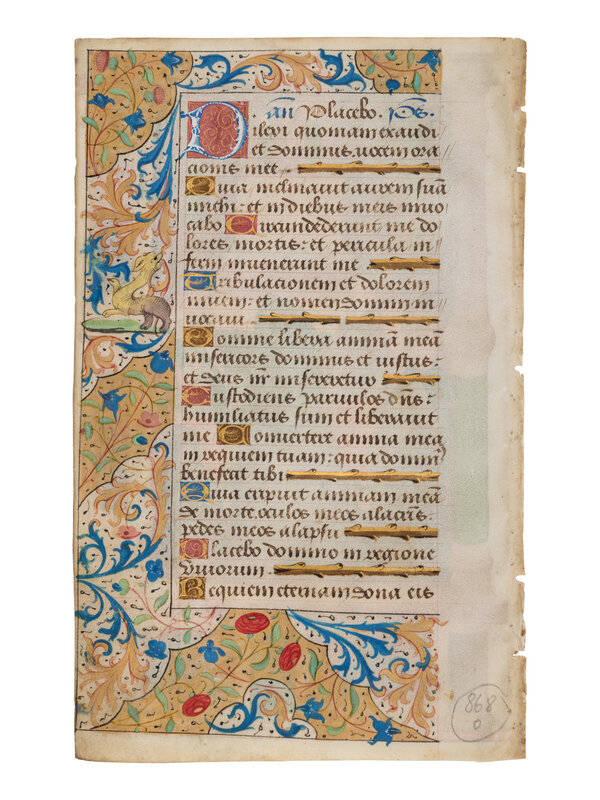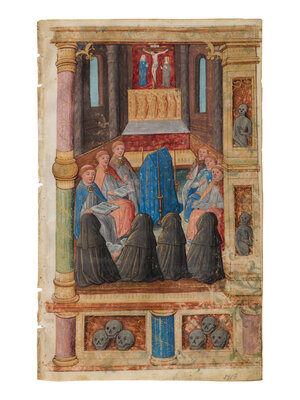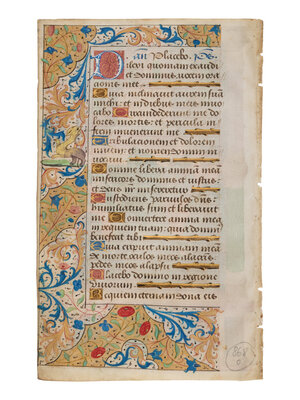Lot 43
MASTER OF THE CLUNY ROMULÉON (active Paris, c. 1480-1500)
A leaf from a Book of Hours, including a full-page miniature of the Funeral Mass, in Latin, illuminated manuscript on parchment [France, Paris, c. 1490-1500]
A leaf from a Book of Hours, including a full-page miniature of the Funeral Mass, in Latin, illuminated manuscript on parchment [France, Paris, c. 1490-1500]
Sale 2033 - Western Manuscripts and Miniatures
Jun 27, 2024
10:00AM CT
Live / Chicago
Own a similar item?
Estimate
$1,500 -
2,000
Price Realized
$1,651
Sold prices are inclusive of Buyer’s Premium
Lot Description
MASTER OF THE CLUNY ROMULÉON (active Paris, c. 1480-1500)
A leaf from a Book of Hours, including a full-page miniature of the Funeral Mass, in Latin, illuminated manuscript on parchment [France, Paris, c. 1490-1500]
A leaf from a Book of Hours, including a full-page miniature of the Funeral Mass, in Latin, illuminated manuscript on parchment [France, Paris, c. 1490-1500]
Exceptional miniature with a powerful reinterpretation of the Funeral Mass, an addition to the oeuvre of the Master of the Cluny Romuléon, who painted one of the treasures of the Musée de Cluny.
192 x 118 mm. Single leaf, ruled in red for one column of 26 lines (written space: 133 x 68 mm), written in brown ink in a gothic bastarda script, rubrics in blue, one-line initials in liquid gold on alternately red, blue, and brown ground, line-fillers as trunked trees highlighted with liquid gold, three-line initial on the verso in blue on red ground with white and gold highlights, accompanied with a three-sided compartmented floral border alternating blank and liquid gold ground, with hybrids and acanthus sprouts, ONE FULL-PAGE MINIATURE set within a liquid gold architectural frame (cockling of the parchment, architectural frame slightly trimmed at outer edge, colors of the verso shining through the recto due to exposure, else in good condition).
This leaf preserves an exceptional full-page miniature that originally introduced the Office of the Dead of an as-yet unidentified late fifteenth-century Book of Hours, of which several leaves are known. It delivers an imaginative reinterpretation of the Funeral Mass, arguably one of the most conventional themes in fifteenth-century book illumination. Monks are here depicted turning their backs at the viewer, seating on a wooden bench resting on the lower bar of the gold architectural frame, alongside two pairs of three clerics seating in rows of perpendicular benches. The setting must have reminded the faithful of the liturgical choir of a church, as is further suggested by the richly furnished altar. The latter combines a red woven frontal with a golden altarpiece of Christ and four standing saints, over which appears a woven or painted panel depicting a colorful Calvary. The architectural frame conceived as an ossuary integrates skulls, thus reminding the faithful of the mortuary theme of the office here introduced and of his coming death.
This miniature and its sister leaves can be attributed to the Master of the Cluny Romuléon, based on distinctive features such as the reddish flesh tones of the male figures, the rounded square-shape of the faces, and the abundant use of liquid gold hatching and highlighting. Formerly named the Master of Morgan 26 by John Plummer, the Master of the Cluny Romuléon was renamed by François Avril after scattered fragments of a Romuléon in the translation by Jean Miélot (Paris, Musée de Cluny, inv. 804, inv. 1819; see Delaunay 2000), which might have been commissioned by René II of Lorraine. He was tasked with the illumination of several Books of Hours printed by Antoine Vérard for Charles VIII. Although a fair number of his clients came from Eastern France, the Master of the Cluny Romuléon appears to have been active in Paris and probably trained alongside Master François, based on the similarities of their palette and taste for openwork architectural frames. The location of his activity is further demonstrated by the secondary decoration of the present leaf, the verso of which offers a distinctive tall and narrow three-quarter layout that compares well with other manuscripts illuminated in late-fifteenth century Paris (see e.g. Paris, BnF, MS lat. 1408).
Provenance
Private collection, California, USA, MS 189.
Sister leaves
Four sister leaves from the collection of the Bosch Foundation were sold in Paris, Hôtel Drouot, Binoche & Giquello, 4 June 2021, lots 3-5: two with full-page miniatures of the Nativity and Presentation in the Temple, two with small miniatures of the Pieta and St. Mark.
LITERATURE
Further literature on the artist, see: J. Plummer, The Last Flowering. French Painting in Manuscripts, 1420-1530, New York/London, 1982, no. 94, pp. 72-73; F. Avril and N. Reynaud, Les Manuscrits à peintures en France, 1440-1520, Paris, 1993, no. 213, 376; I. Delaunay, Échanges artistiques entre les livres d’heures manuscrits et imprimés produits à Paris vers 1480-1500, PhD dissertation, Paris, 2000.
Freeman’s | Hindman thank Senior Consultant Sandra Hindman and Elliott Adam for their assistance in preparing this sale.
Property of a Private California Collector
Condition Report
Contact Information



